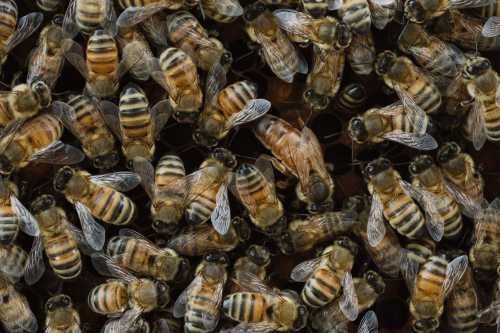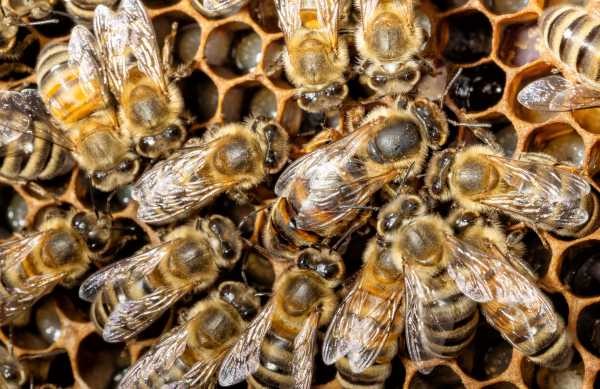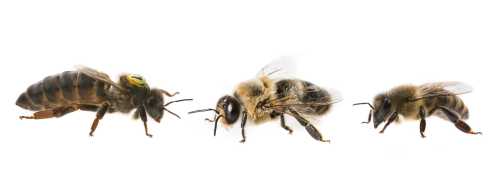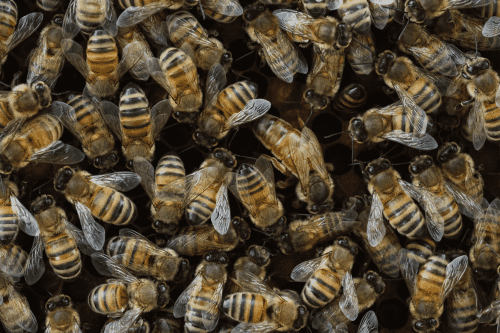Honey Bee Colonies
Honey bees are 'eusocial' species living in colonies consisting of thousands of bees, and belonging to the family ‘Apidae’ .
About Honey Bee Colonies
Honey bee colonies have the characteristics of a 'superorganism'.

A superorganism is an organised group consisting of many individuals, that together function as a whole unit. This efficient organisation of a colony is vital, and all of the bees play an important role in the nest or hive.
As a colony grows eggs hatch and develop, there may be thousands of mouths to feed, honeycomb to build, as well as predators to fight ... all on top of general ‘house-keeping' tasks!
How Many Bees In A Honey Bee Colony?
A typical honey bee colony may have:
1 queen
Up to 50,000 or more very busy workers performing various tasks
300 drones
9000 hungry larvae needing food.
20,000 older larvae and pupae in sealed wax cells, needing to be kept warm.
6000 eggs from which new larvae will hatch.
The Different Roles In The Honey Bee Colony
 A queen with a retinue of workers surrounding her
A queen with a retinue of workers surrounding herThe Honey Bee Queen:
The
main role of the honey bee queen, is to lay thousands of eggs. In
order to be able to lay lots of eggs, she will go off on multiple nuptial flights to mate with different drones1 (the
male bees).
A productive queen can lay about 1,000 eggs per day.
How do honey bees get a new queen?
If the honey bee queen lays too few eggs, her workers will replace her with a new
queen. This is called 'supersedure'.
When do bees swarm?
When the existing colony is large and it's time to split it and establish a new colony, this is achieved by swarming. When the time is right, a new queen is produced in a colony, so there are now 2 queens.
It's actually the original queen who takes off with part of the colony, to start a new one elsewhere, leaving the new queen behind with the rest of the colony.
Workers:
The roles of workers vary depending on their stage of life.
Once a worker bee emerges as an adult, she immediately gets to work, removing waste from cells, and adding a disinfecting material ready for the new eggs.
After around 3 days, she becomes a brood nurse, meaning that it is her job to feed the larvae with pollen and honey. Later, they will feed royal jelly to queen larvae and drones.
After about 16 days, she will begin secreting wax from her abdomen for building hexagonal-shaped honeycombs.
After about 20 days, she will perform guard duties, defending the entrance of the hive or nest from predators. Soon after, she will begin foraging for nectar and pollen to bring back to the hive.
Additional duties of worker bees include: fanning the hive to regulate the temperature, removing dead bees and larvae from the hive, and carrying water to the hive.
Sometimes, honey bee workers lay eggs, but if they develop into adults they will be males (drones).
Drones:
Drones (males) perform the function of mating with queens.
What is the difference between the honey bee queen, workers and drones (appearance)?
 From left tp right, a honey bee queen, drone and worker.
From left tp right, a honey bee queen, drone and worker.The queen is about twice the size of a worker honey bee, and one and a half times the size of a drone, measuring around 2 cm in length. Beekeepers tend to mark the queen with special bee paint on the thorax (upper body) to make it easier to spot her during hive inspections.
Males (drones) differ from females in that they are slightly larger, and have bigger eyes. They will never be seen carrying pollen, since they do not forage for the colony.
References and resources
1. Schlüns H, Moritz RFA, Kryger P. Multiple nuptial flights and the evolution of extreme polyandry in honeybee queens (Apis mellifera L.). Anim Behav. 2005; 70: 125–131
See internal links to further information on this site.
If you found this page helpful or interesting, I'd really be grateful if you would share it with others - if not this page, perhaps another, such as Gardening For Bees.
Thank you so much :) .
